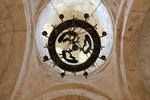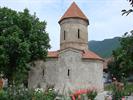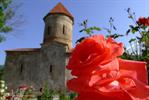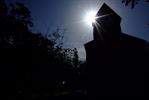Located approximately 5km north of Sheki, and with a population of only 6,244, the tiny village of Kish is a shadow of it's once "mighty" glory. Walking the quiet cobble-stoned streets, you'd never guess that Kish's story is one of an ancient history and of "great" regional importance. Today, not much happens here, but that's the appeal.
In the 1st century A.D. St. Elishe, a disciple of Thaddeus of Edessa, arrived to a place called Gis, where he built a church and recited a liturgy. The church became the "spiritual center and the place of enlightenment of people of the East".
It has functioned at different times as an Caucasian Albanian Apostolic church, a Chalcedonian church within the Georgian Orthodox Church and as an Armenian Apostolic church.
According to a Georgian historiographer, in the 10th century, the population of Kish converted to the Georgian Orthodox Church (Chalcedonism). The church of Kish was turned into a residence of a Georgian bishop, functioning till 17th century.[14] By the time when Russia took possession of the region the village of Kish had Udi population. According to Robert H. Hewsen, the Udi language appeared to have been prevalent north of Kura River until the nineteenth century, and the Armenian population appeared to be of relatively recent arrival. While many Armenians undoubtedly settled there fleeing the Turko-Mongolic invasions, many more entered the region with the coming of the Russians in the early nineteenth century.
In 1836, the Albanian church, along with all active churches in this region that were not Georgian or Russian, was incorporated into the Armenian Apostolic Church, and the Church of Kish was refounded in 1860s and became a place of pilgrimage due to the belief that it was associated with Elishe (Yegishe).
From these early beginnings, Kish became not only a religious centre, but a political capital. The regional capital was initially here. The kingdom revolved around this place for several hundred years. That is until nature stepped in. Several major flood caused them to move the capital down the hill to Sheki, where it later flourished. Rather similar to other mountain villages in the area, in terms of old stone houses and cobble-stoned streets, Kish had a certain "Je ne sais quoi" that others lack.
Peacefully set on either side of a valley, most of the alleyway are inaccessible to traffic. Other than the odd cow or chicken. There is plenty of opportunity to wander through the back streets catching a glimpse of everyday life. There's no running water in the village, so everyone needs to meet at one of the well-springs to get water where they gossip about.
But there is much more than well placed stones here. Kish has something that most other villages of it's kind don't, a real tourist attraction.
The brilliantly renovated round-towered Albanian church (9am-8pm Tue-Sun) in Kish village has been lovingly converted into a very wellpresented trilingual museum. It’s the best place anywhere to learn about mysterious Caucasian Albania, the Christian nation that once covered most of northern Azerbaijan. In fact the church site goes back well beyond the Christian era and glass-covered grave excavations allow visitors to peer down on the excavated bones of possibly Bronze Age skeletons.
The church of Saint Elishe , is sort of what brought people here to begin with. And while traces can be found of the original 1st century site, what we see today is an 800 year old construction. And actually, the Thor Heyerdahl Research Centre analysis of several artifacts dates the site as far back as 3,000BC
Finding the church is a piece of cake. The church is easy to find with well marked signs, in English, pointing the way. Just have faith following them. When it's time to turn, there will be a sign. Even being there at the height of tourist season, there was no one else there. You pay your 80 qapik/cents (or whatever) and check out the site. There are some artifacts in the Church, labelled in English. And although it's not a great architectural achievement in human history, the surroundings are nice and the peace and quiet invaluable. On the site area a couple of unearthed graves. The skeletons unveiled are clearly different. Measuring some 6m tall, some theorist have concluded that Norsk people originated here.
In the delightful cobbled streets around the church you'll find kids playing, old men sporting flat caps, and women fetching water in traditional guyum. There are some charming walks up the river valley towards the Gelersen Gorasan Fortress Ruins, though surrounding areas are being steadily invaded by new bungalow resorts for vacationing Bakuvians, such as comfortable Narin Qala Istrahat Zonasy. For something much cosier, do a village homestay. Tucked away in orchard gardens just three doors from Kish church is the delightful Ilhama's Homestay (98417; bed-only/with food AZN5/10). The well-maintained shower and toilet are outside across the lovely orchard garden. Ilhama speaks some English.
Overcrowded day-time marshrutkas 15 and 23 run a few times hourly from Sheki's Taza Bazaar (20 minutes). To find the church get off near the start of the village and walk 800m, looping round and following the signs.
Kish would easily be ranked as one of tourist favourite places in Azerbaijan. The air is clean, the people are friendly and the atmosphere is great, without question, if in the area, Kish is a must do for any traveller.
Research and dating
In 2000-2003 the Norwegian Ministry of Foreign Affairs funded a joint project between Azerbaijan Architecture and Construction University and the Norwegian Humanitarian Enterprise for the archaeological research and restoration of the church of Kish. Dr. Vilayat Karimov of Baku's Institute of Archaeology and Ethnography served as the director of excavations, and the archaeological advisor for the project was J. Bjornar Storfjell. Radiocarbon analysis of various objects found on the site showed that the cultic site found beneath the altar of the church dates to about 3000 B.C., while the construction of the existing church building dates to about the 12th century (990-1160 A.D.).
The existing church building cannot be dated to the times of St. Elishe, but the archaeological evidence demonstrates that the church is located on an ancient cultic site. It is very unlikely that St. Elishe built in Kish a church in the modern understanding of this word. Even if the person did exist, it appears likely that he built only the altar or used an existing pagan cult structure.
Bjornar Storfjell stated that there's clear evidence that this church was built as Diophysite church. Excavations revealed that the church represented two different periods of use, with two different corresponding floor levels. According to Storfjell, since the architecture of the apse of the original church in Kish suggests a diophysite Christology, and since the Georgian Church was the only diophysite church existing in the Caucasus in the late medieval period, it seems reasonable to suggest that the Kish church was built as a Georgian church and was later taken over by monophysites.
If you're planning a trip to Azerbaijan you may be interested ▶ Azerbaijan highlights - For those who prefer to go unbeaten path, to explore less visited places and check national charisma of this small country in Southern Caucasus on the edge of Europe.

















